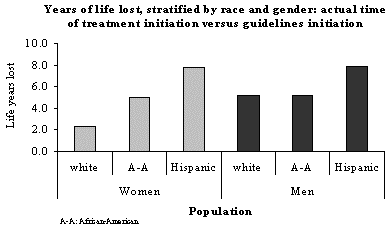| Meeting Brochure and registration form SMDM Homepage | |

|

|
|
||||
Methods: We used published data to derive race- and gender-specific distributions of patient CD4 cell counts at the time of ART initiation. Rates of non-AIDS-related mortality were specified by race and gender. We used the Cost-effectiveness of Preventing AIDS Complications (CEPAC) model, a widely published computer simulation of HIV disease, to estimate life expectancy using different ART initiation criteria: 1) current treatment guidelines of CD4<350/µl or diagnosis of an opportunistic infection (OI), 2) CD4<200/µl or OI, 3) CD4<50/µl or OI, or 4) OI alone. We assumed that all patients who discontinued ART prematurely would resume ART if they developed an OI.
 Results: Estimated mean life expectancy varied from 27.6 years for patients initiating ART according to current treatment guidelines to 11.6 years for those initiating ART only at first OI diagnosis. Premature discontinuation of ART decreased life expectancy under current treatment guidelines by 1.6 to 9.8 years, depending on the number of regimens before discontinuation. Racial disparities in survival loss were more pronounced in women than in men. Assuming a 5% treatment discontinuation rate after each regimen, survival loss was 2.4, 5.0, and 7.8 years for white, African-American and Hispanic women, respectively (Figure). Hispanics had greater survival loss regardless of gender.
Results: Estimated mean life expectancy varied from 27.6 years for patients initiating ART according to current treatment guidelines to 11.6 years for those initiating ART only at first OI diagnosis. Premature discontinuation of ART decreased life expectancy under current treatment guidelines by 1.6 to 9.8 years, depending on the number of regimens before discontinuation. Racial disparities in survival loss were more pronounced in women than in men. Assuming a 5% treatment discontinuation rate after each regimen, survival loss was 2.4, 5.0, and 7.8 years for white, African-American and Hispanic women, respectively (Figure). Hispanics had greater survival loss regardless of gender.
Conclusions: Late presentation and premature discontinuation of HIV care result in substantial survival loss in the US. Racial and ethnic minorities have greater survival loss due to later presentation; disparities by race are even more evident for women. Future outreach efforts should focus on early presentation and retention in HIV care, especially in minority populations.
See more of Poster Session I
See more of The 27th Annual Meeting of the Society for Medical Decision Making (October 21-24, 2005)